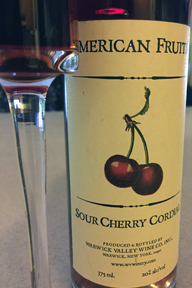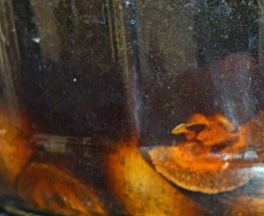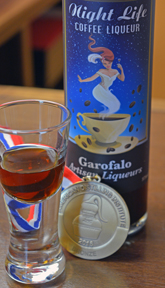
Liqueur
by
Terry and Kathy Sullivan
 A liqueur should not be confused with the word liquor. A liquor refers to a distilled spirit. It includes a liqueur, brandy, gin, rum, whisky, vodka and many others. A liqueur is a liquor that is generally sweet and flavorful. In the United States, the word cordial is used rather than the word liqueur.
A liqueur should not be confused with the word liquor. A liquor refers to a distilled spirit. It includes a liqueur, brandy, gin, rum, whisky, vodka and many others. A liqueur is a liquor that is generally sweet and flavorful. In the United States, the word cordial is used rather than the word liqueur.
Liqueur Process
The process of making a liqueur begins with obtaining a neutral spirit. This neutral spirit could be grain based or fruit, especially grape, based. Different items are added to the neutral spirit in order to add flavor. Some of these flavor items include, fruits, nuts, flowers, spices, herbs and cream. The distiller will use a recipe, some centuries old. If a distiller is making a liqueur without a recipe, it may take several trials before the right recipe of ingredients produces a likable liqueur. Most liqueurs are sweetened. The distiller adds sugar or another sweetener to the liqueur.
 We observed the making of liqueurs at Garofalo Artisan Liqueurs in Winchester, Virginia. One container (pictured left) had a neutral spirit to which raw walnuts were cut in sections and added. In another container, mature walnuts were cracked open and added to a grain alcohol base. The walnuts would remain in the base for a number of months to years. In both cases the resulting liqueur was a dark brown to black color. The recipe is over 100 years old and came from Dick Garofalo’s grandmother.
We observed the making of liqueurs at Garofalo Artisan Liqueurs in Winchester, Virginia. One container (pictured left) had a neutral spirit to which raw walnuts were cut in sections and added. In another container, mature walnuts were cracked open and added to a grain alcohol base. The walnuts would remain in the base for a number of months to years. In both cases the resulting liqueur was a dark brown to black color. The recipe is over 100 years old and came from Dick Garofalo’s grandmother.
Other liqueurs were also made at Garofalo. A ginger and lime infused liqueur was made since this combination is popular among mixologists. Not all liqueurs are infused. The coffee liqueur was made by blending coffee with a neutral base.
History
 Liqueurs have been around for quite awhile. It is believed that they evolved from medicine. As early as the 13th century, liqueurs were prepared and used as medicine. Today, liqueurs are made world-wide.
Liqueurs have been around for quite awhile. It is believed that they evolved from medicine. As early as the 13th century, liqueurs were prepared and used as medicine. Today, liqueurs are made world-wide.
Liqueurs date back to the Middle Ages. Some apothecaries and European monasteries believed the use of liqueurs as medicine was an attempt to use the healing elements of plants. The process of creating medicinal liqueurs included maceration, fermentation, and distillation of botanicals. Some of the first liqueurs were made in Italy in the 1200s. According to the Bénédictine® website all of the Western European countries created elixirs between the 12th century and the 17th century.
One source notes that liqueurs were discovered among ancient Greek scrolls and in the tombs of Egypt.
In Europe, medicinal liqueurs were often made at monasteries; a good example of this is Grand Chartreuse. The history of the Chartreuse liqueur dates back to 1605 when King Heny IV had his Marshall of the artillery send an ancient manuscript to the Chartreuse monastery. This document contained the recipe for Chartreuse also soon to be known as the “Elixir of Long Life.” It was many years before the complicated recipe was totally understood. It contains a whopping 130 herbs and spices. In the early 1700s, the document was sent to La Grande Chartreuse where the document was studied. Eventually in the late 1730s, workable way was available for producing Elixir. Today the Chartreuse monks continue to use this old recipe and the liqueur is called Elixir Vegetal de la Grande-Chartreuse. The recipe survived through the French Revolution, being sold to a pharmacist, Napoleon’s order to send all secret recipes to the government, and was eventually returned to the Chartreuse Monks. Throughout all these years small changes have been made to the recipe to make it more appealing as a beverage rather than as a medicinal drink.
In a French abbey in 1510, a special liqueur named Bénédictine® was crafted by Dom Bernardo Vincelli. But it was not until 1863 that the Bénédictine® recipe was rediscovered by Alexandre Le Grand. Today Bénédictine® is produced with 27 plants and spices.
We will be exploring the history of liqueur in detail; watch for more updates.
Drinking Liqueurs
Because of their sweetness, people can enjoy liqueurs as aperitifs and paired with desserts. Liqueurs can also stand alone as dessert. Many liqueurs are used by mixologists in making cocktails.
Article written October 2016
